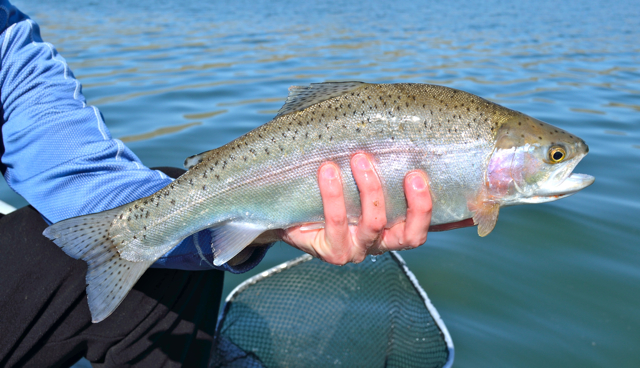Henry’s Fork, July 27th, 2021

Here are excerpts from Ron Van Kirk’s July 27th analysis of the Henry’s Fork drainage water status. We offer these for those interested in the drainage water situation and its impact on fishing during this dry summer and for those planning a visit to any of the drainage’s major waters. Henry’s Fork fishing conditions have changed little since our Saturday, July 24th fishing report. Anywhere you fish the river, be sure to have terrestrial insect patterns in your fly box!
- At 7 degrees F above average, yesterday was the warmest day in a week.
- Forecasts are becoming more certain of substantial rain over the next week, with widespread totals of 1-2 inches.
- Diversion has dropped to 77% of average, while natural flow is 68% of average, putting the difference between supply and demand right at average.
- Outflow from Island Park Dam was reduced to 915 cfs yesterday. The reservoir is 51% full, compared with 73% on average and 42% in 2016.
Details:
Mean temperature yesterday was 7 degrees F above average and the warmest since last Monday. The daily maximum was the warmest since Sunday the 18th. Water-year precipitation to date is still 75% of average. Forecasts are becoming more confident in widespread, wetting rain beginning tomorrow and continuing for at least a week. The current seven-day forecast calls for widespread rainfall totals of at least 1 inch, with up to 3 inches possible on the Yellowstone Plateau. Temperatures will gradually cool to average—something we have not seen since late May. Outlooks at the time frame of 7-14 days give greater-than-even odds of above-average precipitation, something we have also not seen since late May. Overnight low temperatures will increase with the increase in moisture, but daytime highs will cool substantially, reaching 8-10 degrees F BELOW average by early next week.
If the forecast rainfall totals materialize, streamflow will increase substantially by this time next week, especially in Fall River and Teton River. Precipitation of 1-3 inches in headwater areas could increase natural flow by 50% or so, at least briefly bringing natural flow up to average. That much rain would also directly add 500-1000 ac-ft to the surface of Island Park Reservoir, on top of any increases in stream inflow. In addition, an extended period of rain in valley areas would decrease irrigation demand, although that may come at the cost of damage to cut hay and to ripening grain. The duration of precipitation is a critical determinant of the latter—if valley rain is concentrated in a narrow window of a day or two followed by a return to dry weather, grain will dry without sprouting on the stalk. An extended period of rain, such as we experienced in August of 2014, could result in widespread loss of grain crops. The best scenario for both water supply and crop quality is 1-2 days of rain in the valleys, with daily showers in the mountains over an extended period. Right now, that scenario is essentially what is forecast.
For now, natural flow remains very stable at 68% of average: 76% in upper Henry’s Fork, 68% in Fall River, and 57% in Teton River. Diversion continued to drop yesterday and is 77% of average: 81% on Henry’s Fork, 64% on Fall River, and 79% on Teton River. The difference between irrigation demand and natural flow has dropped to only 100 cfs, about average for this time of year.
As expected, natural flow water-rights priority has continued to drop and was at 7/10/1889 yesterday, which reduced available natural flow on several canals in the watershed, prompting further reductions in diversion. However, the upcoming rain will increase natural flow enough that some of the natural-flow rights cut over the past week or so will at least briefly come back into priority next week, allowing more diversion without storage charges to those water users.
As I mentioned yesterday, water management over the next few weeks will be determined by a complex combination of water-rights availability, hay prices (very high right now), and effects of rain on streamflow, crop development and harvest. After two months of very stable albeit hot and dry conditions, August is promising to start off with a little more excitement for us water-data geeks. That said, no long-term changes to drought conditions are expected. Keep in mind that while the heavy rain we received at the end of May temporarily helped fill reservoirs and lowered irrigation demand, it had essentially no effect on drought conditions, which are worse now than they were in May.
Continued decreases in diversion have allowed continued cuts in Crosscut Canal delivery to the Teton River and resulted in increased streamflow in the lower Henry’s Fork. As a result, outflow from Island Park Reservoir was decreased to 915 cfs yesterday, and that decrease is just making its way to the lower watershed this morning. For the 47 days of Island Park Reservoir draft so far this season, streamflow in the Henry’s Fork downstream of all diversions has averaged 342 cfs, compared with the target flow of 350 cfs. The coefficient of variation in daily flow is 30%, meaning that the typical daily departure from the average is around 100 cfs. Outflow from Grassy Lake will be cut to zero this week, further reducing reservoir draft. If the rain materializes as forecast, it is possible that we may even have a few days next week when total reservoir storage in Grassy Lake, Henry’s Lake, and Island Park combined stays constant.
Island Park Reservoir is 51% full, compared with 73% full on average and 42% full in 2016. Total storage in the three reservoirs in the Henry’s Fork watershed is 68% of capacity, compared with 81% full on average and 64% in 2016. The three reservoirs currently contain over 9,000 ac-ft more than on this date in 2016.
Rob Van Kirk, Ph.D.
Senior Scientist
P.O. Box 550
Ashton, ID 83420
208-652-3567 OFFICE
208-881-3407 CELL
208-652-3568 FAX
